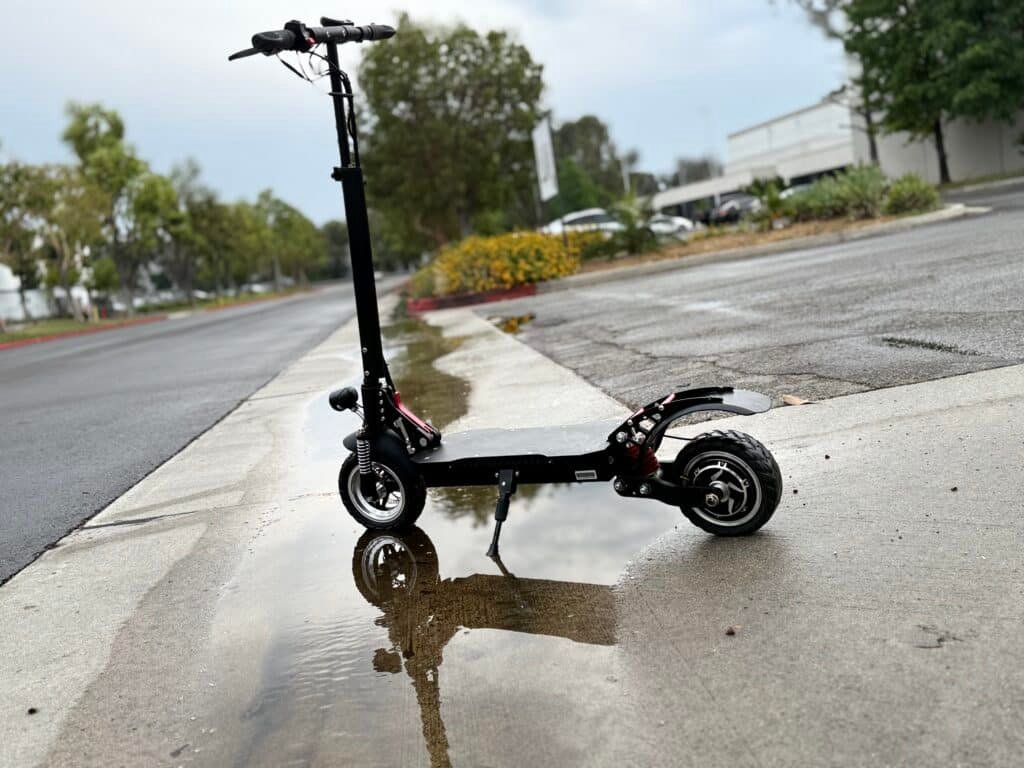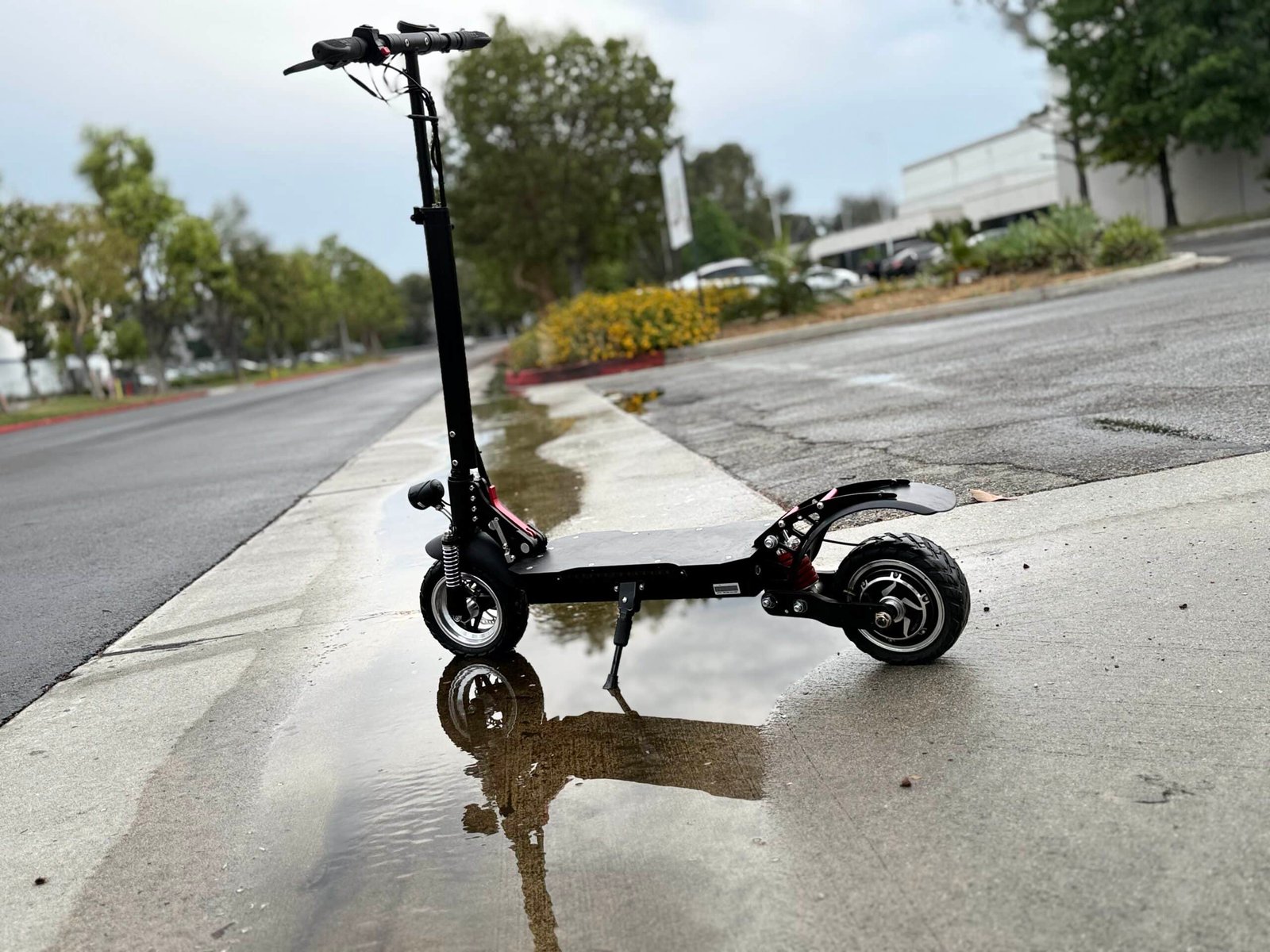Are E-scooters Waterproof?
Many riders are excited to enjoy their electric scooters in all kinds of weather—but what if it starts to rain? Will your e-scooter survive it? Here’s what every rider needs to know to avoid costly mistakes caused by water exposure.
Most electric scooters are not completely waterproof, but many are water-resistant to some degree, depending on their IP rating. Always check the scooter’s specifications or label to understand how much water it can handle. Riding in light rain may be okay, but heavy rain or deep puddles can damage your scooter.

Even though some scooters like those from JUESHUAI have decent waterproof ratings, I always advise caution. Water and electronics don’t mix well. If you're caught in a sudden downpour, it's not the end of the world—but letting your scooter stay wet for too long or ride through heavy rain can cause lasting damage.
How do I know if my electric scooter is waterproof?
Getting caught in the rain with your scooter is stressful. You worry if it’ll survive. You wonder if the water will seep in and ruin the motor or the battery. I’ve had customers message me after leaving their scooters out in a drizzle for an hour, unsure whether they just broke a $1000 machine.
To check if your e-scooter is waterproof, look for its IP rating in the product specifications or on accessory labels. The IP (Ingress Protection) rating shows how resistant your scooter is to dust and water. The higher the second digit, the better it is at keeping water out.

Understanding IP Ratings and What They Mean
The IP rating system is simple once you get the hang of it. Here's how to read it:
| IP Rating | Meaning | Can Ride in Rain? | Notes |
|---|---|---|---|
| IPX4 | Splash-resistant | Light drizzle only | Avoid puddles |
| IP54 | Dust + splash-resistant | Light to moderate rain | Not waterproof |
| IP55 | Dust + low-pressure jets | Short periods in rain | Dry immediately |
| IP67 | Dust-tight + water immersion up to 1m | Yes (short immersion) | Rare for scooters |
Most JUESHUAI scooters are at least IP54, which gives decent protection against splashes and light rain. But even then, I always recommend drying the scooter after use and never riding through deep puddles or during storms. Water always finds a way in if we get careless.
Can electric scooters get wet in the rain?
You’re out on your scooter and it starts to rain. Do you panic? Should you pull over? I get this question a lot from first-time buyers and even experienced riders.
Yes, electric scooters can get wet to a certain extent—especially those rated IP54 or higher—but prolonged exposure or riding through heavy rain can damage the internal electronics, battery, and motor. Always dry the scooter after use and avoid submerging it in water.

Why Water Exposure is a Big Deal for E-scooters
Water might seem harmless, but to an electric scooter, it’s a slow killer. Here's why:
1. Water + Metal = Rust
Most scooters use aluminum alloy, which resists rust, but smaller steel components can still corrode. Over time, moisture can eat away at brake bolts, bearing cases, and suspension parts.
2. Water + Battery = Short Circuit
If water gets inside the battery housing, the result can be dangerous. Some batteries have protective casings, but not all are sealed for full immersion.
3. Water + Motor = Power Loss
Brushless motors can tolerate minor splashes, but water that gets into the wiring or motor casing causes inconsistent power, reduced speed, and overheating.
I’ve personally opened up scooters that had water pooled near the controller or inside the deck. The damage isn’t always instant—it’s the slow corrosion over weeks that ruins parts silently.
Does water affect an electric scooter?
Many riders think a little rain or moisture doesn’t matter. But over time, it does. I've seen it in repairs—motors not spinning right, rusted screws that break off, and display screens that flicker.
Yes, water can seriously affect an electric scooter’s performance and lifespan. It can cause corrosion, short circuits, and failures in the motor or controller. Even water vapor trapped inside the housing can harm sensitive electronics over time.
Real Consequences of Moisture Buildup in Scooters
If a scooter isn’t dried properly after a rainy ride, here's what can happen over time:
| Component | Damage Caused by Water | Signs of Trouble |
|---|---|---|
| Battery | Short circuit, swelling | Sudden power loss, won't charge |
| Controller | Signal disruption | Jerky throttle, error codes |
| Motor | Corrosion, resistance | Weak acceleration, odd noises |
| Bearings | Rust and wear | Rough ride, squeaky wheels |
These issues usually start small. A few days of squeaking. A flicker on the display. Then one day, the scooter doesn’t start. That’s why I tell my customers: water might not kill your scooter today, but it’ll shorten its life if you ignore it.
How to protect electric scooter accessories from water damage?
Some riders do everything right with the scooter body but forget the accessories. Displays, throttles, charging ports, and lights—these are often more vulnerable than the deck itself.
To protect your e-scooter accessories from water damage, keep your scooter dry when not in use, cover the charging port1 with its rubber cap, wipe the handlebar and dashboard areas after rain, and store the scooter in a dry, cool place.

Steps I Recommend to Keep Everything Safe
Over the years, I’ve shared these simple practices with dozens of shop owners and riders:
1. Use a Waterproof Cover
Especially when parking outside. A cover shields the deck and accessories from rain and morning dew.
2. Dry After Every Ride
Use a clean towel. Don’t forget under the deck and near the wheel hubs.
3. Charge Indoors Only
Never charge your scooter while it’s wet. Let it dry for at least an hour.
4. Inspect Seals and Caps
The rubber covers on the charging port and switches wear out over time. Replace them if they get loose.
5. Add Extra Silicone Seals
If you're confident, open the deck and seal the controller and battery case with extra silicone. Some riders even apply waterproof spray to outer cables.
These habits may take a few extra minutes, but they save you from big repairs2 down the road. I tell all my retail partners to make this a standard recommendation3 to their customers—it’s a simple way to keep returns and complaints low4.
Conclusion
Electric scooters can handle a little water, but not a lot. Knowing your scooter’s waterproof rating and taking a few extra steps to protect it can save you money and stress in the long run.
Table of Contain
-
Learn the best practices for covering your e-scooter's charging port to prevent water damage and ensure longevity. ↩
-
Understanding the benefits of preventing big repairs can help you save money and time in the long run. Explore this resource for valuable insights. ↩
-
Discover effective strategies for retail partners to minimize returns and enhance customer satisfaction through standard recommendations. ↩
-
Learn proven methods to keep returns and complaints low, ensuring a smoother operation and happier customers. This resource is a must-read! ↩






